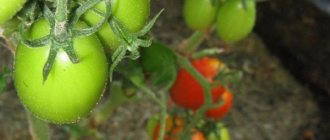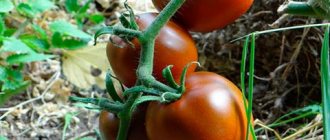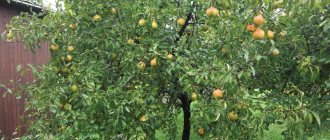Description of the variety
The salad variety Cardinal is grown mainly in central Russia in greenhouse conditions. The advantages of large fruits include resistance to tomato diseases.
Cardinal is a tall plant. The stem grows more than one and a half meters. Therefore, it must be tied up.
From the moment of sprouting until the first harvest of tomatoes is harvested, 110-120 days pass. The heart-shaped fruits do not ripen all at once, but depending on the level of the clusters. The first fruits begin to ripen in early July. But the bush will continue to form inflorescences and ovaries until the end of summer.
The fruits are quite large: 300-800 g in weight. From one bush you can harvest 4-7 kg of tomatoes.
Pink tomatoes with thin skin are good for salads. They can also be canned and pickled. There will be no problems with storage and transportation due to their density.
Why choose Cardinal tomato?
Modern gardeners face a difficult choice; there are too many varieties and hybrids offered to their attention. Summer residents with experience have their own proven tomatoes, although they are always ready to try new items. It’s more difficult for beginners, and this is where the Cardinal tomato comes to the rescue, which will show good results in your beds in the summer season.
In the characteristics and description of the variety, we note the following qualities:
- unpretentiousness;
- large and very tasty fruits;
- excellent presentation of tomatoes;
- high yield rates;
- resistance to infections.
This is a semi-determinate tomato, and if in Indets you need to pinch off the growing point, then in Cardinal, after the formation of a certain number of clusters (usually 8-12), the stem grows up on its own. If you wish, you can collect seeds from this tomato and sow them next year.
Flaws:
- narrow “specialization” of the variety, since due to the large size of the fruits it cannot be used for preservation;
- The bush needs pinching and gartering.
It is unlikely that these “cons” are critical, because otherwise the productive Cardinal will satisfy even the most biased gardeners.
Landing
Cardinal seeds should be planted in March. Before planting, soak the seeds in fresh aloe juice overnight. You can also soak for half an hour in a weak solution of potassium permanganate, then rinse the planting material with water.
The soil for planting should be light with the addition of humus, wood ash and superphosphate. You can use peat pots. Bring them into a warm place to warm up, fill them with soil, sprinkle with heated water, plant the seeds to a depth of one and a half centimeters and cover with plastic wrap.
Before germination, the container with seedlings must be kept at a temperature of at least 25 degrees. When sprouts appear, move the containers closer to the light, but not in direct sunlight. If there is not enough sun, use the backlight.
Growing seedlings
As soon as the second true leaf appears, the seedlings should be plucked. Replant into pots, water well and fertilize with minerals, and mulch. The second time, the bushes are fertilized immediately before planting in the ground.
You can plant each bush of Cardinal seedlings in a separate peat glass to plant the plant in the ground along with it.
It is better not to use a watering can for watering seedlings - only a spray bottle. At the same time, avoid excess moisture so that the roots do not rot. Water early in the morning or evening.
During this period, be sure to harden the tomatoes: take the pots for a while to a cool place without drafts.
Landing in the ground
At the end of May - beginning of June, the seedlings are transplanted into open ground. To do this, dig holes at a distance of half a meter from each other, adding wood ash to each. Having planted tomatoes, they should be immediately tied to pegs. The garter will have to be done several more times as the bushes grow, so choose the pegs as high as possible.
After planting, water the plants with warm water and cover them with polyethylene for a while, creating a greenhouse effect. Each tomato bush produces 10-12 ovaries, so regularly pinch the growing point.
You cannot plant tomatoes after eggplants, peas, peppers, and potatoes. If tomatoes grew in this place last year, it is better not to use it either. And onions, cabbage, and beans are good predecessors for Cardinal.
Appearance of the bush and fruits
Cardinal forms a semi-determinate, compact but tall bush with a powerful root system. In a greenhouse its height reaches 1.8–2 m, in open ground - 1.5–1.6 m. The foliage is average, medium-sized, slightly corrugated leaves are colored light green. The fruit begins to set above the 8th or 9th leaf. Then brushes are formed every 1–2 sheets.
The fruits of the Cardinal tomato are heart-shaped, large in size and red in color with a raspberry tint.
The rounded fruits are heart-shaped and slightly ribbed on the sides. They are colored red-crimson. The skin covering them is thin and matte. The number of chambers and seeds inside is small. The pulp is juicy and sugary. Tomatoes have a classic taste and pleasant aroma.
Inside the Cardinal tomato fruit there is a fleshy and sugary pulp, and the size of the seed chambers is small
Care
Caring for Cardinal consists of properly forming the bush and trimming the lower leaves and shoots. Leave two stems.
For watering, one bucket of water poured under the bush once every 7-10 days will be enough. Do not wet the leaves and fruits under any circumstances. Hill up once every three weeks.
This variety is not very susceptible to diseases, but it is better to play it safe and spray young plants with a weak solution of potassium permanganate. A soap solution will help get rid of aphid infestations. To prevent slugs from attacking the bushes, treat them with ammonia diluted with water.
You should definitely fight weeds between the rows and add mulch - straw, peat, humus. The soil should be loosened 2-3 times a month.
Cardinal tomatoes on video
If you grew Cardinal tomatoes, please write whether you liked them or not. What was the yield and taste of the fruits in your climatic conditions? Would you grow them again and recommend them to others? Briefly describe the advantages and disadvantages of this tomato in your opinion. If possible, attach a photo of the fruit or the entire bush. Thank you!
Your reviews of the Cardinal tomato will help many gardeners evaluate this variety objectively and decide whether it is worth planting or not.
This is a natural variety of tomato. Therefore, we recommend taking seeds from a ripe fruit and using them for planting in subsequent seasons.
Choosing a place and soil for planting
It is best to plant in an open sunny area.
You should not plant tomatoes in a garden bed where eggplants, peas, peppers, tomatoes, and potatoes previously grew. But where onions, cabbage, and beans grow, you even need to plant tomatoes.
Cardinal tomatoes love nutritious light soil . As planting soil, you can use turf or garden soil mixed with humus. The addition of superphosphate or wood ash will have a positive effect on growth and development.
Pests and diseases
The Cardinal variety is quite resistant to viral and fungal diseases.
However, other plants may become the culprits of infection. Land turnover will help avoid problems. Tomatoes are planted in beds that were occupied by legumes, cabbage or carrots. It is not recommended to plant tomatoes in places where peppers, potatoes or eggplants grew. In a greenhouse, you need to change the top layer of soil every season, spilling it with a solution of potassium permanganate or copper sulfate. To prevent greenhouses and greenhouses, it is necessary to frequently ventilate and destroy weeds between the rows. Mulching the soil with peat, straw or humus also helps. It is recommended to spray young plants with phytosporin and a pale pink solution of potassium permanganate.
In greenhouses and open ground, tomatoes can be affected by pests. The most common species found are aphids, naked slugs, thrips and whiteflies. In hot summers, seedlings and young plants can be attacked by spider mites. Pests need to be controlled from the first days of plant life. The soil for seedlings is calcined in the oven (at a temperature not lower than 60 degrees). This procedure effectively destroys larvae in the soil.
At least once a week, seedlings and adult plants should be inspected, always looking under the leaves. If you find cobwebs or sticky streaks, you need to wash them off with a damp cloth and then spray the plant with a weak solution of potassium permanganate. Regular spraying with warm water with the addition of ammonia will help destroy slugs. You can get rid of aphids by washing off the pests with warm soapy water.
Insecticides that help against spider mites are diluted according to the instructions on the package, and then the plantings are treated 2-3 times at intervals of several days. Tomatoes can be sprayed with chemicals before the flowering period begins; during fruit ripening, toxic agents are prohibited.
“Cardinal” is an interesting variety, suitable for greenhouses. Its resistance to disease makes it suitable for beginning gardeners. If desired, seeds for propagation can be collected from your own bushes, increasing the plantation without extra costs.
Pros and cons of the Cardinal variety
Strawberry Cardinal
Cardinal tomatoes are universal, they are consumed raw, cold, and hot dishes. In reviews, users share recipes for preparing delicious juices, sauces, purees, and salads. Cardinal tomatoes are especially tasty when marinated. The fruits have a pleasant tomato aroma, firm but not hard skin, and a fleshy, juicy composition.
Canned tomato
The culture takes root well in greenhouses and greenhouses, and germinates quickly in open ground. The variety is resistant to bad weather conditions. Many note the good quality of planting material, which is widely used by beginning gardeners and professionals. Seeds from your own bushes are suitable for propagation, allowing you to increase your plantation without additional costs. The advantages of the variety also include early stable (up to frost) fruiting, high resistance to drought, and resistance to diseases characteristic of Solanaceous crops.
There are few disadvantages of the Cardinal tomato; their role is not critical for growing the crop; the list of key features includes:
- the need to form a bush to increase productivity;
- mandatory tying of plants at the stage of planting and stem growth;
- the impossibility of salting the fruits of the first fruiting entirely due to their large dimensions;
- Maintaining high air temperatures for the yield and pronounced taste of tomatoes; greenhouse placement will ensure favorable conditions.
Cardinal tomatoes are an excellent solution for residents of regions with a warm temperate climate. In areas with cool summers and early frosts, tomatoes will produce a good harvest if greenhouse conditions are created.
The most common diseases and pests
The main reason why Cardinal is affected by diseases and pests is improper care of tomatoes. Some mistakes can lead to the death of the plant. As a result, fungi appear. To protect the plant from damage, young seedlings need to be treated with fungicides.
Among the pests, the most dangerous are mold, spider mites, and aphids. At the first attacks of pests, tomatoes are treated with high-quality insecticides.
The Cardinal variety is a crop that has gained popularity among gardeners due to the high yield and durability of the plant. Following basic rules will allow you to get tasty and juicy fruits.
Cultivation technology and crop care
To get a wonderful harvest, it is necessary to carry out planting work correctly and provide the crop with complete and comprehensive care.
Growing and planting seedlings
To harvest in mid-July, it is recommended to plant seeds for growing seedlings in mid-March. The planting material has excellent characteristics - its germination parameters reach 90%. It is recommended to plant seedlings in early March. To do this, you need to prepare a soil mixture and add humus, wood ash and superphosphate to it.
Seeds should be soaked in water or a growth stimulant. This needs to be done for 12 hours. Then the planting material is transferred to the seedling box. First, you need to make depressions up to 2 cm in size in the soil.
After planting, the soil must be moistened using a spray bottle and covered with a transparent film. The room temperature must be maintained at +24-25 degrees.
After the first shoots appear, it is recommended to move the box with seedlings to a well-lit room. This will ensure rapid growth of cultural shoots. When the first leaves appear, the seedlings should be planted in individual containers. It is also worth adding mineral fertilizers to them. They help improve plant characteristics.
The crop is grown in seedlings
Before planting tomatoes in open ground, they need to be taken out to the balcony for half an hour. This will help harden the seedlings and adapt to new conditions.
The timing of planting depends on climatic conditions and the method of cultivation. For example, it is permissible to plant tomatoes in a greenhouse in early May. They are moved to open ground if there is no threat of return frosts. At the time of planting, the age of the seedlings should be 50-60 days.
To carry out planting work, you should follow these recommendations:
planting density is 5 bushes per 2 square meters; the distance between bushes should be 55-60 cm; during planting, it is important to ensure that the roots are located in a coma of the earth; after planting, the tomatoes are covered with film for several days; each bush should be fed with mineral preparations and wood ash; The top of the bed should be covered with a layer of mulch - this helps retain moisture and helps prevent the growth of weeds.
Moderate watering
It is recommended to water tomatoes of this variety moderately. If there is an excess amount of moisture, there is a risk of plant death. For watering, you should use soft and warm water. It needs to be poured directly onto the bush.
Tomatoes need moderate watering
Mulching the soil
This procedure helps reduce the need for weeding and loosening the soil, reduces the likelihood of being affected by diseases and pests, and provides protection to the roots. The procedure helps increase productivity and saturate the soil with useful elements. Dry straw is usually used as mulch.
Harvesting
Up to 10 large tomatoes can be formed per 1 bunch. They ripen gradually throughout the summer. The first harvest can be obtained in mid-July. The first tomatoes weigh 900 g, the last ones - no more than 400 g. The average fruit weight is 600 g.
Tomatoes have a bright pink-raspberry color and an unusual heart-shaped shape. Inside there is sweet and juicy pulp. It contains some seeds.
This variety is characterized by high yield
Since tomatoes contain a lot of sugar, many people prefer to eat them fresh. At the same time, tomatoes of this variety can also be used for preparing various preparations - purees, sauces, juice. The crop yield parameters are impressive. From 1 square meter you can get up to 14-15 kg of tomatoes.
Tomatoes of this variety have excellent taste. To achieve success in growing a crop, it is necessary to provide it with complete and high-quality care. Control of diseases and pests is of no small importance.









